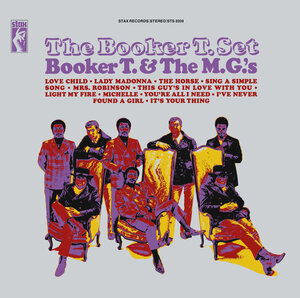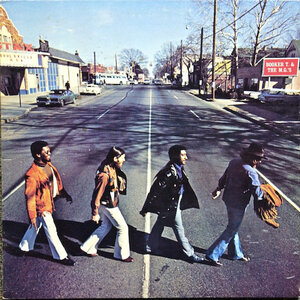A 12-year-old kid is at a local Woolworth’s store on Ashland Avenue on the South Side of Chicago. It’s the early ‘70s, and he’s spending his few allowance dollars on cheap “cut-out” vinyl albums, shelved at the front end of the checkout counter, neatly tiered, four rows high and ten albums deep.

That twelve-year-old was me, and that Woolworth was where I spotted my very first Booker T. & the M.G.’s album—The Booker T. Set[STS 2009]. The neon-color negative print images of the band on the cover immediately caught my attention. The ominous-looking red, orange, and purple shapes of the band members’ bodies stood in stark contrast to the glossy, platinum-silver background. At bargain-bin prices of ninety-nine cents, I snapped it up and brought home my prize.
Booker T.’s specialty—beyond playing the organ—was creating instrumental covers of songs. I didn’t know the original versions of most songs on The Booker T. Set, so I took what I heard on the album at face (ear?) value. For example, The Supremes’ “Love Child” wasn’t familiar to me, and Simon & Garfunkels’s “Mrs. Robinson,” or Burt Bacharach’s “This Guy’s In Love With You”, weren’t tunes that 12-year-old me had been exposed to yet. But Sly & The Family Stone’s “Sing a Simple Song” was familiar, as was as The Isley Brothers’s “It’s Your Thing” and Eddie Floyd’s “I’ve Never Found Me A Girl”. Those were songs that I recognized from the urban/soul radio stations we listened to at home. Still, almost immediately, the Booker T. & the M.G’s version of all these tunes became my official version—I still know note-for-note every melody and solo on that album.

The Booker T. Set was released in May 1969, followed by the epic McLemore Avenue in January 1970, whose cover depicts Jones and the M.G.’s walking across McLemore Avenue to Stax’s studio, much as The Beatles do on their Abbey Road album as they cross Abbey Road to Abbey Road Studios. The connection to the Beatles cover was deliberate, and the appreciation between both bands was mutual. John Lennon apparently was an avid Stax fan, and lovingly called Booker T. & the M.G.’s “Book a Table and the Maître d’s.” Jones said of the album Abbey Road, “I thought it was incredibly courageous… and they were the top band in the world. The music was just incredible, so I felt I needed to pay tribute to it.”
From the first opening statement—a burst of five staccato notes on the pitch of G—I knew something special was going on, and a bit different than what I’d experienced on The Booker T. Set. Indeed, McLemore Avenue was Booker T. Jones’s unique way of interpreting the songs on the classic Beatles album. Blissfully ignorant, I literally had no point of reference at the time regarding the musical inferences being made, nor did I have any idea that McLemore Avenue’s “street-crossing” cover photo was an homage to Abbey Road’s.
It took me years to discover that those five staggered notes that begin the first track, “Golden Slumbers,” represent Paul McCartney’s legendary vocal phrase, “Once there was a way…”. Jones’s instrumental rendition is significantly more laid-back than Paul’s vocal delivery. Creating dark, round tones with his Hammond B3, Jones gives the melody a delicate texture, before he picks up speed for the medley “Carry That Weight/You Never Give Me Your Money”, just as the track is sequenced on Abbey Road. In Jones’s hands, “You Never Give Me Your Money “ is more galloping and funkified than the Abbey Road’s version.
Al Jackson’s drum solo that follows“Carry That Weight/You Never Give Me Your Money” is executed perfectly, recreating, to a T, down to its tribal “tom-tom” techniques, Ringo’s drum solo on Abbey Road’s “The End”, while Cropper’s biting, trebly tone captures the sound of John’s and George’s own guitar sounds.Interestingly, you get to hear some vocals on the Booker T. album when Jones sings the words to“The End”. The song then segues into“Here Comes the Sun”, which, unlike the brisk, straight-eight tempo of the original, assumes a medium-tempo, swingin’ 6/8 shuffle that sounds like Booker T. Jones strutting down the street with a cavalier attitude. Al Jackson’s playing and his sound come through incredibly clean and crisp. And Duck Dunn’s bass playing is as solid and swinging as it gets.
From here, Jones dovetails seamlessly into a seriously funky version of “Come Together”, wherein Cropper performs a series of stinging choruses of guitar solos, creating an intense surge in forward energy before falling back into the melody. Finally, a hip version of “Something”that begins with acoustic piano, ends with a propulsive, rhythmic thrust and a rapid-fire, crackling snare riff that closes Side 1 with a pop!

Side 2opens with “Because,” a slow, more solemn and smoldering rendition of the Beatles’s more harmonies-layered original, followed by a reprise of “You Never Give Me Your Money,” this time using the repeated “1-2-3-4-5-6-7” fade-out present on Abbey Road.
“Sun King” is one of my favorite pieces on the entire album—sooo soft and mellow, with Jones offering a wide array of gorgeous tones from the draw bars of his B3. Then, staying true to the original sequence, the band launches into “Mean Mr. Mustard/Polythene Pam/She Came in Through the Bathroom Window.”
The following “I Want You/She’s So Heavy/The End”also faithfully recreates the Beatles sequence,and indeed this is where the album ends—with a blistering, swirling organ solo over the repeated chord vamp played by the band.
There’s so much to enjoy on this album that it’s easy to forget there were three pieces left out of the tribute: “Maxwell’s Silver Hammer,” “Oh! Darling,” and “Octopus’s Garden.”
It may seem hard to believe that anyone who listens to McLemore Avenue wouldn’t make the connection to the Beatles’s Abbey Road album. But it’s true—I had no idea, because I’d never heard the songs on Abbey Road. Because of that, I experienced McLemore Avenue in the most innocent and naïve way. Indeed, the album was a joyous thing to discover.










Leave a Reply